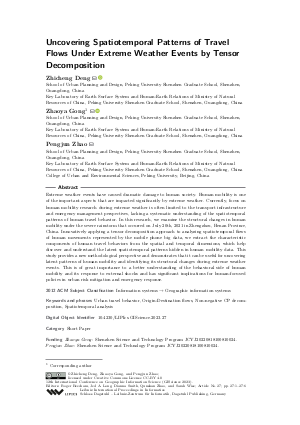Uncovering Spatiotemporal Patterns of Travel Flows Under Extreme Weather Events by Tensor Decomposition (Short Paper)
Authors
Zhicheng Deng  ,
Zhaoya Gong
,
Zhaoya Gong  ,
Pengjun Zhao
,
Pengjun Zhao
-
Part of:
Volume:
12th International Conference on Geographic Information Science (GIScience 2023)
Part of: Series: Leibniz International Proceedings in Informatics (LIPIcs)
Part of: Conference: International Conference on Geographic Information Science (GIScience) - License:
 Creative Commons Attribution 4.0 International license
Creative Commons Attribution 4.0 International license
- Publication Date: 2023-09-07
File

PDF
LIPIcs.GIScience.2023.27.pdf
- Filesize: 6.55 MB
- 6 pages
Document Identifiers
Subject Classification
ACM Subject Classification
- Information systems → Geographic information systems
Keywords
- Urban travel behavior
- Origin-Destination flows
- Non-negative CP decomposition
- Spatiotemporal analysis
Metrics
- Access Statistics
-
Total Accesses (updated on a weekly basis)
0PDF Downloads0Metadata Views
Abstract
Extreme weather events have caused dramatic damage to human society. Human mobility is one of the important aspects that are impacted significantly by extreme weather. Currently, focus on human mobility research during extreme weather is often limited to the transport infrastructure and emergency management perspectives, lacking a systematic understanding of the spatiotemporal patterns of human travel behavior. In this research, we examine the structural changes in human mobility under the severe rainstorm that occurred on July 20th, 2021 in Zhengzhou, Henan Province, China. Innovatively applying a tensor decomposition approach to analyzing spatiotemporal flows of human movements represented by the mobile phone big data, we extract the characteristic components of human travel behaviors from the spatial and temporal dimensions, which help discover and understand the latent spatiotemporal patterns hidden in human mobility data. This study provides a new methodological perspective and demonstrates that it can be useful for uncovering latent patterns of human mobility and identifying its structural changes during extreme weather events. This is of great importance to a better understanding of the behavioral side of human mobility and its response to external shocks and has significant implications for human-focused policies in urban risk mitigation and emergency response.
Cite As Get BibTex
Zhicheng Deng, Zhaoya Gong, and Pengjun Zhao. Uncovering Spatiotemporal Patterns of Travel Flows Under Extreme Weather Events by Tensor Decomposition (Short Paper). In 12th International Conference on Geographic Information Science (GIScience 2023). Leibniz International Proceedings in Informatics (LIPIcs), Volume 277, pp. 27:1-27:6, Schloss Dagstuhl – Leibniz-Zentrum für Informatik (2023)
https://doi.org/10.4230/LIPIcs.GIScience.2023.27
BibTex
@InProceedings{deng_et_al:LIPIcs.GIScience.2023.27,
author = {Deng, Zhicheng and Gong, Zhaoya and Zhao, Pengjun},
title = {{Uncovering Spatiotemporal Patterns of Travel Flows Under Extreme Weather Events by Tensor Decomposition}},
booktitle = {12th International Conference on Geographic Information Science (GIScience 2023)},
pages = {27:1--27:6},
series = {Leibniz International Proceedings in Informatics (LIPIcs)},
ISBN = {978-3-95977-288-4},
ISSN = {1868-8969},
year = {2023},
volume = {277},
editor = {Beecham, Roger and Long, Jed A. and Smith, Dianna and Zhao, Qunshan and Wise, Sarah},
publisher = {Schloss Dagstuhl -- Leibniz-Zentrum f{\"u}r Informatik},
address = {Dagstuhl, Germany},
URL = {https://drops.dagstuhl.de/entities/document/10.4230/LIPIcs.GIScience.2023.27},
URN = {urn:nbn:de:0030-drops-189228},
doi = {10.4230/LIPIcs.GIScience.2023.27},
annote = {Keywords: Urban travel behavior, Origin-Destination flows, Non-negative CP decomposition, Spatiotemporal analysis}
}
Author Details
- School of Urban Planning and Design, Peking University Shenzhen Graduate School, Shenzhen, Guangdong, China
- Key Laboratory of Earth Surface System and Human-Earth Relations of Ministry of Natural Resources of China, Peking University Shenzhen Graduate School, Shenzhen, Guangdong, China
- School of Urban Planning and Design, Peking University Shenzhen Graduate School, Shenzhen, Guangdong, China
- Key Laboratory of Earth Surface System and Human-Earth Relations of Ministry of Natural Resources of China, Peking University Shenzhen Graduate School, Shenzhen, Guangdong, China
- School of Urban Planning and Design, Peking University Shenzhen Graduate School, Shenzhen, Guangdong, China
- Key Laboratory of Earth Surface System and Human-Earth Relations of Ministry of Natural Resources of China, Peking University Shenzhen Graduate School, Shenzhen, Guangdong, China
- College of Urban and Environmental Sciences, Peking University, Beijing, China
Funding
- Gong, Zhaoya: Shenzhen Science and Technology Program JCYJ20220818100810024.
- Zhao, Pengjun: Shenzhen Science and Technology Program JCYJ20220818100810024.
References
-
Michael Batty. The new science of cities. MIT press, 2013.

-
Francesco Calabrese, Mi Diao, Giusy Di Lorenzo, Joseph Ferreira Jr, and Carlo Ratti. Understanding individual mobility patterns from urban sensing data: A mobile phone trace example. Transportation research part C: emerging technologies, 26:301-313, 2013.

-
Boyeong Hong, Bartosz J Bonczak, Arpit Gupta, and Constantine E Kontokosta. Measuring inequality in community resilience to natural disasters using large-scale mobility data. Nature communications, 12(1):1870, 2021.

-
IPCC. Climate Change 2023: Synthesis Report. A Report of the Intergovernmental Panel on Climate Change. IPCC, Geneva, Switzerland, (in press), 2023.

-
Marianna Loli, George Kefalas, Stavros Dafis, Stergios A Mitoulis, and Franziska Schmidt. Bridge-specific flood risk assessment of transport networks using gis and remotely sensed data. Science of the Total Environment, 850:157976, 2022.

-
Tao Pei, Stanislav Sobolevsky, Carlo Ratti, Shih-Lung Shaw, Ting Li, and Chenghu Zhou. A new insight into land use classification based on aggregated mobile phone data. International Journal of Geographical Information Science, 28(9):1988-2007, 2014.

-
Amnon Shashua and Tamir Hazan. Non-negative tensor factorization with applications to statistics and computer vision. In Proceedings of the 22nd international conference on Machine learning, pages 792-799, 2005.

-
The State Council Disaster Investigation Team. Investigation report on '720' heavy rainfall disaster in zhengzhou,henan. Technical report, The State Council of People’s Republic of China, 2022.

-
Brian Tomaszewski. Geographic information systems (GIS) for disaster management. Routledge, 2020.

-
Qi Wang and John E Taylor. Patterns and limitations of urban human mobility resilience under the influence of multiple types of natural disaster. PLoS one, 11(1):e0147299, 2016.

-
Yang Xu, Jiaying Xue, Sangwon Park, and Yang Yue. Towards a multidimensional view of tourist mobility patterns in cities: A mobile phone data perspective. Computers, Environment and urban systems, 86:101593, 2021.

